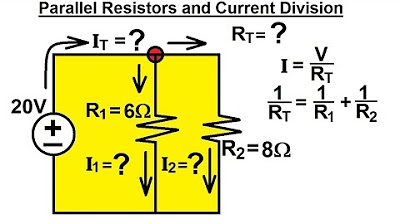Experimental Verification Of Ohm's Law and Finding Unknown Resistance | BOARD PRACTICAL | Std 10-12
Summary
TLDRThis video provides a hands-on demonstration of Ohm's Law, showcasing how to determine the resistance of an unknown resistor in a simple circuit. The presenter explains how a battery eliminator converts AC to DC, with an emitter measuring current and a voltmeter recording voltage across the resistor. Using a rheostat to adjust resistance, the voltage-current relationship is shown to be linear, confirming Ohm's Law. By calculating voltage divided by current, the unknown resistor's value is determined to be 5 ohms. This practical experiment reinforces the theoretical concept of Ohm's Law and its application in circuit analysis.
Takeaways
- 😀 The video demonstrates Ohm's Law using a simple circuit setup with a battery eliminator, emitter, resistor, and voltmeter.
- 😀 The battery eliminator converts AC power to DC power, allowing users to adjust the output voltage (1.5V to 12V).
- 😀 The emitter is connected in series with the unknown resistor and has very low internal resistance to ensure the current flows through the resistor.
- 😀 The voltmeter is connected in parallel with the resistor to measure the potential difference across it, without allowing current to flow through it.
- 😀 The relationship between voltage, current, and resistance is illustrated by Ohm's Law: V = I * R, where V is voltage, I is current, and R is resistance.
- 😀 The rheostat (variable resistor) is used to change the resistance in the circuit, affecting the current and voltage.
- 😀 The resistance of the rheostat can be adjusted by changing the number of turns of its metal wire, which increases or decreases the length of the conductor.
- 😀 In a series circuit, the total resistance is the sum of the individual resistances, and the current remains the same throughout the circuit.
- 😀 As the resistance increases, the current decreases, and as the resistance decreases, the current increases in a linear relationship.
- 😀 By taking readings of voltage and current, a graph can be plotted, where the slope (V/I) gives the resistance value of the unknown resistor, which in this case is 5 ohms.
Q & A
What is the purpose of the battery eliminator in the circuit?
-The battery eliminator converts AC (alternating current) from the power supply into DC (direct current), providing a stable DC output for the circuit. This allows for precise control of the voltage applied to the resistor.
Why is the emitter connected in series with the resistor?
-The emitter is connected in series with the resistor to measure the current flowing through the circuit. Since the current in a series circuit is the same at all points, it ensures that the same current flows through both the emitter and the resistor.
What is the function of the voltmeter in the circuit?
-The voltmeter is connected in parallel with the resistor to measure the potential difference (voltage) across it. It should not allow current to flow through it, which is why it has a very high internal resistance.
Why do we need to keep the internal resistance of the voltmeter high?
-The internal resistance of the voltmeter needs to be high to prevent it from drawing current through itself, which would interfere with the measurements. The current must flow through the resistor, not the voltmeter.
How does the rheostat work in the circuit?
-The rheostat is a variable resistor that allows you to adjust the total resistance in the circuit. By changing the position of the rheostat’s knob, you change the number of turns in the metal wire, thus varying the resistance.
What happens to the current when the resistance is increased by the rheostat?
-When the resistance is increased by the rheostat, the current decreases because the overall resistance in the circuit has increased, following Ohm’s law (V = IR).
What is the relationship between voltage and current in this experiment?
-The relationship between voltage and current in this experiment is linear. As the voltage increases, the current also increases, demonstrating that they are directly proportional, in accordance with Ohm’s law.
How do you calculate the resistance from the measurements of voltage and current?
-Resistance can be calculated using Ohm's law, where resistance (R) is the ratio of voltage (V) to current (I). For example, if V = 2V and I = 0.4A, then R = V/I = 2V/0.4A = 5 ohms.
What does the slope of the voltage vs. current graph represent?
-The slope of the voltage vs. current graph represents the resistance of the resistor. According to Ohm’s law, the slope (V/I) is equal to the resistance (R).
What is the calculated resistance of the unknown resistor in the experiment?
-The calculated resistance of the unknown resistor is 5 ohms. This was determined by measuring voltage and current at different points and using Ohm's law to calculate the resistance.
Outlines

Cette section est réservée aux utilisateurs payants. Améliorez votre compte pour accéder à cette section.
Améliorer maintenantMindmap

Cette section est réservée aux utilisateurs payants. Améliorez votre compte pour accéder à cette section.
Améliorer maintenantKeywords

Cette section est réservée aux utilisateurs payants. Améliorez votre compte pour accéder à cette section.
Améliorer maintenantHighlights

Cette section est réservée aux utilisateurs payants. Améliorez votre compte pour accéder à cette section.
Améliorer maintenantTranscripts

Cette section est réservée aux utilisateurs payants. Améliorez votre compte pour accéder à cette section.
Améliorer maintenantVoir Plus de Vidéos Connexes

O que é um Circuito Elétrico

Electrical Engineering: Basic Laws (2 of 31) Ohm's Law

La legge di Ohm - Tutorial di elettronica - #2

Basic Electricity - Resistance and Ohm's law

Dasar Teknik Elektro - Seri Pembagi Tegangan

Electrical Engineering: Basic Laws (14 of 31) Parallel Resistors and Current Division
5.0 / 5 (0 votes)
